
Helen’s tree frog. Photo courtesy of Jodi Rowley.
Jodi Rowley is no stranger to discovering new amphibians—she’s helped describe over 10 in her short career thus far—but she was shocked to discover a new species of flying frog less than 100 kilometers from a major, bustling Southeast Asian metropolis, Ho Chi Minh City. Unfortunately, the new frog, dubbed Helen’s tree frog (Rhacophorus helenae), may be on the verge of extinction, according to the description published in the Journal of Herpetology.
“To discover a previously unknown species of frog, I typically have to climb rugged mountains, scale waterfalls and push my way through dense and prickly rainforest vegetation,” Rowley with the Australian Museum explains. “I certainly didn’t expect to find a new species of frog sitting on a fallen tree in lowland forest criss-crossed by a network of paths made by people and water buffalo, and completely surrounded by a sea of rice-paddies.”
Measuring 10 centimeters long, the new species is described as a giant flying frog. Flying frogs don’t actually fly, but instead use webs between their hands and feet to glide from one tree to another. Researchers believe Helen’s tree frog went unnoticed for so long, because it stuck to the high canopy.
The frog persists in just two lowland forest patches in southern Vietnam, not far from Ho Chi Minh City: Nui Ong Nature Reserve and Tan Phu Forest. The forests are 30 kilometers apart and surrounded by agriculture, making it impossible for the two population to meet.
“It is likely that [Helen’s tree frog] was once widespread over southern Vietnam but now persists in small fragments of remaining
lowland forest. The continued survival of [Helen’s tree frog] is threatened by further habitat loss and degradation due to
encroachment (e.g., livestock grazing and collection of forest products) and habitat isolation,” the researchers write in the paper.
Lowland rainforests are incredibly scarce in this part of the world where booming populations, agriculture, and industrial development have left most standing forests only on hillsides and in mountains.
“Another, more well-known species reliant on lowland forests, the Javan rhino, was confirmed extinct in Vietnam in October 2011,” says Rowley. “The new species is at great risk due to ongoing habitat loss and degradation—the greatest threat to amphibians throughout Southeast Asia—but hopefully it has been discovered just in time to help protect it.”
Rowley says that more information is needed before scientists decide how best to proceed in conservation efforts.
“The first step is finding more about the species—is it really just distributed in a couple of lowland forest fragments or it is more widely distributed? What is the population size of the species? Both these things are going to be incredibly hard to figure out, due to the arboreal nature of the frog. Based on what we know at the moment, I’d say the frog is likely to be highly threatened—primarily by habitat loss and modification.”
Rowley named the new species after her mother, who was recently diagnosed with ovarian cancer.
“To be told I was to have a frog named after me was wonderful, I don’t know anyone who has had anything named after them,” Rowley’s mother, Helen, said.

The edge of Nui Ong Nature Reserve. Photo courtesy of Jodi Rowley.

Another view Helen’s tree frog. Photo courtesy of Jodi Rowley.
CITATION: Jodi J. L. Rowley, Dao Thi Anh Tran, Huy Duc Hoang & Duong Thi Thuy Le (2012). A New Species of Large Flying Frog (Rhacophoridae:
Rhacophorus) from Lowland Forests in Southern Vietnam. Journal of Herpetology. 46:480-487.
Related articles
Vampire and bird frogs: discovering new amphibians in Southeast Asia’s threatened forests
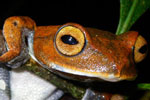
(02/06/2012) In 2009 researchers discovered 19,232 species new to science, most of these were plants and insects, but 148 were amphibians. Even as amphibians face unprecedented challenges—habitat loss, pollution, overharvesting, climate change, and a lethal disease called chytridiomycosis that has pushed a number of species to extinction—new amphibians are still being uncovered at surprising rates. One of the major hotspots for finding new amphibians is the dwindling tropical forests of Southeast Asia.
Pictures: 126 new species discovered in Greater Mekong region last year
(12/18/2012) Some 126 new species were described in Asia’a Mekong region last year, notes a new report published by the World Wildlife Fund (WWF).
Meet Cape Town’s volunteer ‘toad shepherds’
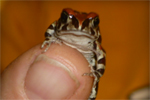
(11/08/2012) August marks the last month of winter in South Africa, and, as temperatures begin to rise, activists in Cape Town prepare for a truly unique conservation event. Every year at this time western leopard toads (Amietophrynus pantherinus) endemic to the region and Critically Endangered, embark on a night-time migration through Cape Town from their homes in the city’s gardens to the ponds they use as breeding sites—as far as three kilometers away. This season over one hundred volunteers took to the streets, flashlights in hand, to assist the toads in navigating the increasing number of man-made obstacles in their path. Among them was life-long resident and mother, Hanniki Pieterse, who serves as an organizer for volunteers in her area.
New rare frog discovered in Sri Lanka, but left wholly unprotected
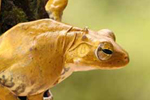
(11/05/2012) Sri Lanka, an island country lying off the southeast coast of India, has long been noted for its vast array of biodiversity. Islands in general are renowned for their weird and wonderful creatures, including high percentages of endemic species—and Sri Lanka, where scientists recently discovered a new frog species, is no exception.
Artificial ‘misting system’ allows vanished toad to be released back into the wild
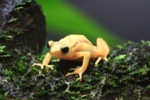
(11/01/2012) In 1996 scientists discovered a new species of dwarf toad: the Kihansi spray toad (Nectophrynoides asperginis). Although surviving on only two hectares near the Kihansi Gorge in Tanzania, the toads proved populous: around 17,000 individuals crowded the smallest known habitat of any vertebrate, living happily off the moist micro-habitat created by spray from adjacent waterfalls. Eight years later and the Kihansi spray toad was gone. Disease combined with the construction of a hydroelectric dam ended the toads’ limited, but fecund, reign.
Teetering on the edge: the world’s 100 most endangered species (photos)

(09/10/2012) From the Baishan fir (five left in the world) to the Sumatran rhino (around 250), a new report highlights the world’s top 100 most endangered species, according to the the International Union for Conservation of Nature (IUCN) and the Zoological Society of London (ZSL). The list spans the taxonomic gamut, from fungi (Cryptomyces maximus) to amphibians (the Table Mountain ghost frog) to flowers (the Cayman Islands ghost orchid) and much more (see full list at the end of the article).
Tiny new frog discovered in India bypasses the free-swimming tadpole stage
(09/07/2012) A tiny new frog species has been discovered in the rainforests of India’s Western Ghats.
Private reserve safeguards newly discovered frogs in Ecuadorian cloud forest
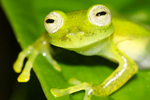
(08/28/2012) Although it covers only 430 hectares (1,063 acres) of the little-known Chocó forest in Ecuador, the private reserve las Gralarias in Ecuador is home to an incredible explosion of life. Long known as a birder’s paradise, the Reserva las Gralarias is now making a name for itself as a hotspot for new and endangered amphibians, as well as hundreds of stunning species of butterfly and moth. This is because the reserve is set in the perfect place for evolution to run wild: cloud forest spanning vast elevational shifts. “The pacific slope cloud forests […] are among the most endangered habitats in the world,” explains Reserva las Gralarias’ founder, Jane Lyons, in a recent interview with mongabay.com.
Climate change may be worsening impacts of killer frog disease
(08/13/2012) Climate change, which is spawning more extreme temperatures variations worldwide, may be worsening the effects of a devastating fungal disease on the world’s amphibians, according to new research published in Nature Climate Change. Researchers found that frogs infected with the disease, known as chytridiomycosis, perished more rapidly when temperatures swung wildly. However scientists told the BBC that more research is needed before any definitive link between climate change and chytridiomycosis mortalities could be made.